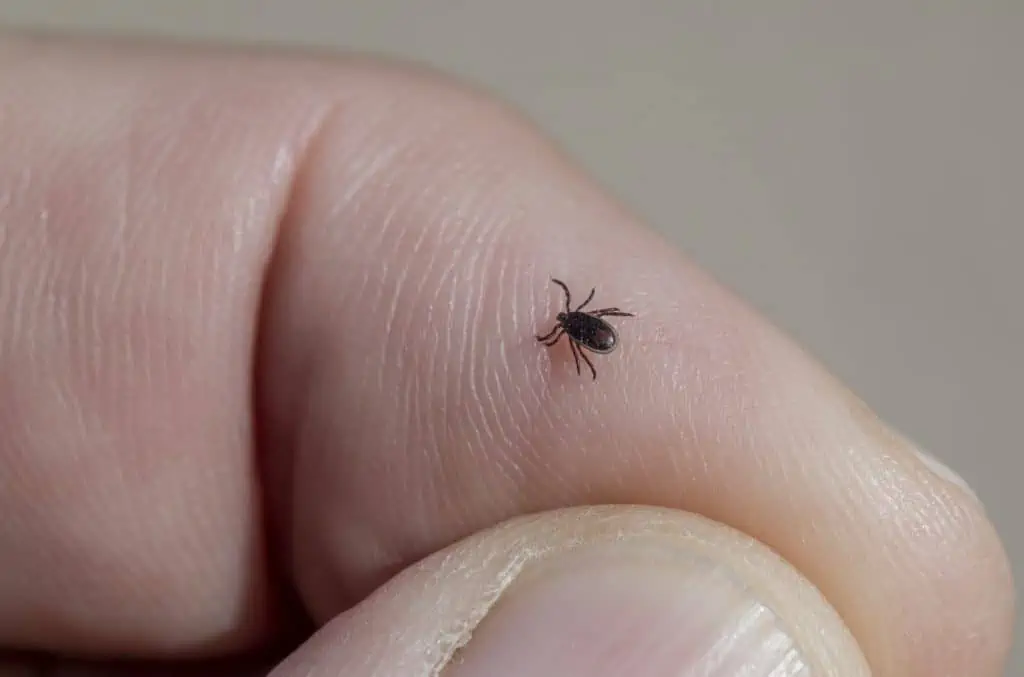Are you wondering how you can protect your dog from ticks and tick bites this summer?
In today’s article, we are talking about the best tick repellent for dogs. But before we begin, let’s take a moment to first talk about ticks, what they are, and why they are so dangerous to our four-legged friends.
Contents
What Are Ticks And Why Are They Dangerous To Our Dogs?
Ticks carry serious and sometimes even deadly diseases.
Although ticks are commonly called insects, they are actually arachnids closely related to spiders, mites, and even bedbugs. Ticks are also considered parasites due to the fact that they cannot survive without the help of an animal host.
It is estimated that there are around 850 different species of ticks throughout the world, with 90 of those species alone living in the United States.
Although we typically consider ticks to be problematic pests, there are some species of ticks that are beneficial to a healthy ecosystem.
Many species of ticks are helpful decomposers, helping to break down wood and other organic matter in forests and fields.
However, there are some species of ticks in the United States that are not only a nuisance but may even be deadly.
The Black Legged Tick
Scientifically known as the Ixodes scapularis, or commonly called the Deer Tick, the Black-Legged Tick is one of the most dangerous ticks in the United States. Females are especially notorious for attacking larger hosts like deer, people, and pets.
Black-Legged ticks are most common from October through May, and they are known to carry and spread some devastating diseases.
Some of the most common diseases carried and transmitted by the Black-Legged tick to people and pets include:
- Lyme disease
- Babesiosis
- Anaplasmosis
- And More
The Lone Star Tick
The Lone Star Tick, also known as Amblyomma americanum, is another common and medically important tick to both people and pets in the United States. This tick spans a wide region, reaching the southeastern, eastern, and south-central United States.
Lone star ticks have three life stages including larva, nymph, and adult. The tick is dangerous in all stages, as it can feed on humans and pets during all three.
Not only will lone star ticks feed on humans, but they are also known to be particularly aggressive. In their larval and nymph stage, they can be quite small, making them difficult to identify on the skin or beneath the fur of a dog.
Although Lone Star ticks are not known for causing Lyme Disease to people and pets, they can carry and transmit a number of other medically important illnesses. Some of the most serious illnesses transmitted by the Lone Star tick include but are not limited to:
- Ehrlichia Chaffeensis
- Tularemia
- STARI
- And Ehrlichia ewingii
Why Is Tick Repellent For Dogs So Important?
Ticks are sometimes very small and therefore difficult to see.
Tick bites can be very dangerous for both people and pets.
With that said, there are times when our canine counterparts are safe from tick-borne illnesses, even after receiving a tick bite.
In fact, for a tickborne illness to be transmitted, most ticks must bite and feed on a dog, cat, or even human for at least 48 hours. Before 48 hours is up, there is a good chance you will notice the tick on yourself or on your pet.
Still, you may not always be able to pinpoint when you or your pet picked up the tick in question, so it’s important to take the proper precautions when removing a tick and then to monitor yourself, your family member, or your pet for any signs of illness.
Some of the most dangerous tick-borne diseases transmitted to dogs from a tick bite include:
- Anaplasmosis
- Lyme Disease
- Ehrlichiosis, Rocky Mountain Spotted Fever
- Bartonellosis
- Babesiosis
- And Hepatozoonosis
Keep in mind that tick-borne illnesses present themselves about 30 days after the initial bite. Symptoms of a tick-borne illness in your dog can include but may not be limited to:
- Swelling around the joints
- Fever
- Vomiting
- Diarrhea
- Muscle Pain
- Lethargy
- And Lameness
Which Dogs Are Most Susceptible To Tick Bites?
Dogs are curious and tend to get into areas that are ideal environments for ticks.
All unprotected dogs can be susceptible to tick bites, even dogs that primarily live their lives indoors.
In fact, experts point out that dogs are generally at much higher risk of coming into contact with ticks than cats are due to their curious nature. Dogs tend to follow their noses, and they are not afraid of poking around in the brush, dead tree stumps, and romping through overgrown fields.
All of these environments are ideal environments for ticks, which can easily latch onto your dog and hide beneath the fur while they feed.
Perhaps most concerning, unprotected pets put people at higher risk for potential tick bites. This is because pets can carry ticks back into the home, transmitting them indoors, where the tick will soon seek out a new host to feed.
Dogs are also at a higher risk for illness from a tick bite because ticks are more difficult to find on their bodies, allowing the parasite a longer time to feed and therefore a better chance to transmit disease.
The most common places for ticks to hide on dogs include along the neck, sides, back, underbelly, behind the ears, in the ears, between the toes, around the groin, and in the pits of both the front and hind legs.
This is why routine checks are so important when it comes to protecting your dog from ticks. Of course, checking your dog is not the only way you can go about protecting your dog. In fact, there are several types of tick repellent for dogs you can use as well.
What To Look For In The Best Tick Repellent For Dogs
When looking for the right tick repellent for your dog, it’s important you do your research.
There are a few different types of tick repellent you can look for when looking for the best tick repellent for dogs. In fact, many types of tick repellent for dogs work not only to repel ticks, but also other pests like mosquitoes, fleas, gnats, and even biting flies.
Some tick repellents work by using chemical ingredients including a small amount of insecticide designed to repel and kill ticks that attack.
Using tick repellent for dogs that contain insecticide has been somewhat controversial, though most experts agree that the risk of side effects is minimal and that the risk of a tick bite to an unprotected dog is generally more dangerous than the ingredients in the repellent.
Furthermore, there are different ways you can go about applying specific tick repellent products for your dog, including utilizing sprays, chews, tick-repellent dog clothing, tick repellent collars or bandanas, and more.
We should also point out that there are several different types of tick repellent for dogs, and not all tick repellent for dogs contains chemicals.
Natural Tick Repellent
Natural flea and tick repellent for dogs is becoming more and more popular, although experts are on the fence as to whether or not natural tick repellent for dogs works as well as chemical repellents.
This type of tick repellent generally works using plant-based ingredients like essential oils to repel ticks and other pests from biting your dog.
There are pros and cons to using natural tick repellent for dogs. Some pros include the fact that natural tick repellent is free of harsh chemicals or ingredients. They are therefore more likely to be less risky to your dog’s health.
Natural tick repellents are often friendlier for the environment, and even safer to use around children.
However, natural tick repellent for dogs may not be as effective when it comes to protecting your dog from certain pests. This is especially true if you live in an area that is known to be populated with dangerous ticks, or if your dog is especially adventurous.
Chemical Tick Repellent
Most chemical tick repellent for dogs works using a small amount of insecticide, as we mentioned above. The most common active ingredients in chemical tick repellent for dogs are generally going to be chemicals like tetrachlorvinphos, pyrethrins, s-methoprene, fipronil, or etofenprox.
Some of these chemical ingredients contain an insect growth regulator or IGR, which will stop larval staged insects from growing or eggs from hatching.
You can invest in chemical tick repellent for dogs in a number of different application styles, including spot treatments, clothing options, collar treatments, tablets, or chews, as we discussed above.
Some pros to using chemical tick repellent for dogs is that this type of repellent is known to be generally effective. Chemical tick repellent for dogs can also help to protect your dog from a wide variety of pests like ticks, fleas, gnats, biting flies, and mosquitoes.
Chemical tick repellent may also be longer-lasting, providing your dog with more overall protection when he is out and about.
However, chemical flea and tick repellents are not free of risk. Because they contain chemicals, these types of repellents can be hazardous to your pet’s health if they are not applied correctly.
Homemade Tick Repellent
Last but not least, you also have the option of making your own tick repellent out of products you already have in your kitchen or medicine cabinet.
Homemade tick repellent for dogs presents many of the same pros and cons as natural tick repellent products do, as they are often made with essential oil and other natural ingredients that may be safer for your dog when applied topically, but which may also not be as effective as chemical tick repellents or as long-lasting.
If you’re not sure which type of tick repellent for dogs would be best for you, we are here to help. We have listed some of our favorite tick repellent products below.
The Best Natural Tick Repellent For Dogs
Natural tick repellents for dogs are often made with ingredients like essential oils.
Natural tick repellent for dogs is often made with plant-based ingredients like essential oils, as we mentioned above. It’s important to remember that if you do decide to invest in natural tick repellent for dogs, it should still be considered a pest repellent product and used only as directed.
Remember too that dogs are sensitive to certain smells, so while a natural tick repellent may be safer for your dog, the scent of that tick repellent could be irritating.
Use a small amount of any type of repellent on a small area of your dog first before spraying your dog down with a natural repellent.
Are you wondering which natural tick repellent for dogs may be best for you and your four-legged friend? Here are some of our top picks!
Vet’s Best Flea and Tick Repellent
No products found.
Vet’s Best Flea and Tick Repellent for dogs is made with certified natural essential oils like peppermint oil. The product is perfectly safe to spray directly on your dog to protect him from ticks and fleas, and you can also spray it on his bedding, on furniture, carpets, upholstery, and other surfaces around your home. The ingredients work to kill fleas and ticks on contact.
Beloved Pets Flea and Tick Repellent Treats
No products found.
Another natural tick repellent for dogs we would recommend are the tick repellent treats listed above. These treats are natural soft chews dogs love and ticks hate. You can order these treats in different flavors including bacon and beef.
They are formulated by veterinarians and contain hemp and other ingredients that repel fleas, ticks, and mosquitoes.
Dog Whisperer Flea and Tick Repellent
No products found.
The Dog Whisperer spray is another all-natural flea and tick repellent for dogs that works using essential oils and plant-based ingredients. You can order it in different package sizes depending on your needs, and we especially like that you can use this product not only on your dog but also on your own skin and any hiking or camping equipment as well.
The Best Chemical Tick Repellent For Dogs
Chemical tick repellents generally use a small amount of insecticide to protect dogs from ticks.
First and foremost, it’s important that you never use products that contain DEET on your dog when it comes to tick repellent. In fact, experts warn against using any type of tick repellent or pest control product on dogs if it is not explicitly labeled for use on pets.
If you’re not sure if a product is safe to use on your dog, it is best to forgo using it and do further research until you find something that is safe.
Although chemical tick repellents can be a scary thought, most experts point out that any tick repellent specified for canine application is going to be made with a very small amount of chemical ingredients or insecticides.
Furthermore, most tick repellent for dogs is made with pyrethrins, which are in their own way a natural, plant-based insecticide commonly derived from flowers.
Still, dogs with sensitives could have aversive reactions to chemical tick repellents, and it’s important to read the directions carefully before deciding which type of chemical tick repellent for dogs is right for your pup.
Also keep in mind that if your dog is sensitive to having topical ointments or sprays, you can choose to invest in tick-repellent clothing, collars, or bandanas.
K9 Advantix ll Flea And Tick Prevention
No products found.
The K9 Advantix Flea and Tick repellent for dogs comes in the form of a liquid application drop. These drops are safe for dogs in all their life stages and are ideal for large breed dogs between the weight of 21 to 55 pounds.
The active ingredient in these drops is permethrin, which is a form of insecticide that is used to repel and kill pests like ticks, fleas, and mosquitoes.
Seresto Flea and Tick Collar
No products found.
Seresto is a popular brand that makes flea and tick collars for dogs of all sizes. This product repels fleas and ticks using a small amount of insecticide. The colors are odorless, non-greasy, and provide up to 8 months of protection just 24 hours after the collar is applied.
The specific order above is for small breed dogs, though you can order this collar for large and medium-sized dogs as well.
How To Make Your Own Tick Repellent For Dogs At Home
You can boil lemon in water and add essential oils to make your own tick repellent spray for dogs.
There are a few ways you can go about protecting your dogs from ticks both inside and outside of your home, and you can combine different tactics to offer your dog and family the most protection possible.
If you are looking to make your own homemade tick repellent for dogs on the spot, you may be in luck.
Chances are you have some, if not all, of the ingredients it takes to make your own tick repellent for dogs at home.
Best Essential Oils To Repel Ticks
Essential oils have long been used as a natural form of pest control and to protect both animals and people from pests like ticks, fleas, spiders, biting gnats, mosquitoes, and more.
When it comes to the best essential oils to keep ticks away from dogs, the top contenders are:
- Eucalyptus
- Peppermint Oil
- Tea Tree Oil
- Cedarwood Oil
- Geranium oil
- Garlic Oil
- Lavender Oil
- And Pennyroyal Oil
Because dogs are much more sensitive than humans are when it comes to smell, it’s important to never put undiluted essential oil directly on your dog. Instead, be sure to dilute essential oils with water and other ingredients to ensure your dog does not have an aversive reaction.
Household Products That Repel Ticks
Like most insects and arachnids, ticks are sensitive to certain smells. While some of the below household ingredients do stir up debate amongst experts as to whether or not they really work to repel ticks or protect your pets from ticks, we think they are worth listing:
- Cinnamon
- Lemon
- Orange
- Vinegar
- Coffee Grounds
- And Pepper
Now we should note here that many of the above household ingredients and spices may not only deter ticks, but also your dog. Hot pepper, cinnamon, and coffee grounds, for example, can all be natural deterrents for a variety of animals, including your dog.
Unless you are creative in the ways you are using some of the above products to repel ticks around your home in general, we suggest avoiding using these products topically on your canine counterpart.
How To Repel Ticks Using Garden Plants
Speaking of repelling ticks around your home, one great way to protect your pets from becoming a tick’s next meal is to protect your yard.
Companion planting is an excellent way to keep ticks and a number of other pests out of your home and away from your dog’s run or playpen.
Some of the best plants you can plant around your home and garden to repel ticks include:
- Mint
- Pyrethrum
- Sage
- Eucalyptus
- Lavender
- Garlic
- Pennyroyal
- Rue
- Rose Geranium
- Fleabane Dasiy
- Chrysanthemums
- And Beautyberry
While many of these plants work well as natural tick repellents for dogs, keep in mind too that some of these plants can be toxic to dogs if ingested. Plants like garlic, lavender, pennyroyal, and chrysanthemums are not ideal to have in yards where curious dogs may have access to them.
Before using companion planting as an alternative or in conjunction with tick repellent for dogs, it’s best to do your research and speak with your veterinarian.
How To Make Your Own Tick Repellent For Dogs Spray
You can use a few of the above ingredients to make your own tick repellent for dogs at home. We like this easy spray recipe you can use that is safe and effective to use on dogs for the short term when it comes to protecting them from ticks and fleas.
Ingredients:
- 1 Spray Bottle
- 1 Quart of Boiling Water
- 1 Sliced Lemon
- 10 Drops of Lemongrass Oil
- 10 Drops of Citronella Oil
- 1 Cup of White Vinegar
- 3 Drops of Cedarwood Oil
Directions:
Bring the quart of water to a boil and add the sliced lemon to the water, then allow to steep overnight. In the morning, drain the lemon water into a spray bottle and add the essential oils and vinegar.
Shake the bottle until the mixture is combined, then spray a very small amount on a patch of your dog’s coat. Monitor your dog for about 20 minutes to ensure he does not have a reaction before spraying him lightly with the mixture.
You may also spray this mixture on a bandana or collar, or on your dog’s walking equipment as well for extra added protection.
You will need to reapply this tick repellent for dogs once every few hours for the best results.
Protecting Your Dog From Ticks – Tips From Experts
Protecting your dogs from ticks is important not only for your dog’s overall health but also for the health of your human family members.
Using a quality tick repellent for dogs is a great way to protect your dogs from ticks, fleas, and many other nasty biting bugs. However, a tick repellent for dogs is not the only way you can help keep your dog safe from these dangerous pests.
There are several other methods you can use to protect your pets, home, and family from ticks and pests year-round.
Take a look!
Keep Up With Yard Maintenance
Ticks prefer landscapes that are overgrown and cluttered. They also prefer woodpiles, tall grasses, and areas where wild animals tend to roam. You can help keep ticks and bay and protect your pets by keeping your lawn mowed short, removing debris and clutter from around your home, and keeping woodpiles away from areas your pets may play.
Make Sure Your Pet Wears A Tick Repellent For Dogs During Tick Season
If you live in an area that is active with ticks, it’s very important to make sure your pet wears a tick repellent for dogs year-round. If you have a specific time of year that might constitute as tick season, be sure your dog is protected during those times.
Remember, all dogs can be at risk of ticks, even dogs that are not outside as often as others.
Do Not Allow Your Dog To Run Through Overgrown Fields Or Woods During Tick Season
Although your dog may enjoy running through overgrown fields or meadows, it’s best to avoid this behavior unless your dog is protected with a quality tick repellent product. Even then, if your dog does run free through brush or overgrowth, be sure to check your dog thoroughly before bringing him inside.
Keep Up With Routine Veterinarian Appointments
Your veterinarian may be able to help pinpoint illnesses that are due to tick bites, even if you aren’t aware your dog has been bitten. Early diagnosis of tick-borne illnesses often leads to the best outcome when it comes to treatment.
Furthermore, your veterinarian is often your best resource when it comes to preventative care and tick repellent for dogs.
Keep Up With Routine Grooming Practices
Grooming your dog at least once or twice a week can help you to catch any ticks or abnormalities on your dog’s body. When you are grooming your dog, be sure to look in places ticks are known to hide.
Begin at the base of your dog’s head and work your way down over his body. Pay special attention to the pits of his arms and hindlegs, his ears, beneath his tail, and between the pads of his toes.
Use A Pest Control Product To Keep Wild Animals Away From Your Property
Last, be sure to use a quality pest control product around your home and property. Not only will an insect repellent be key to ensuring you protect your pets and family from ticks, but an animal repellent that helps keep wild animals at bay will also play a role in keeping ticks from getting too close.
Remember, the primary host for ticks are going to be wild animals like deer, rabbits, raccoons, and coyotes.
You can help keep ticks off of your property and away from your loved ones by keeping their hosts away as well.
And there you have it – the best tick repellent for dogs! Are you considering making your dog’s tick repellent at home?
Tell us what you think about DIY tick repellent for dogs in the comment section below.


Jen Jones is a professional dog trainer and behavior specialist with more than 25 years of experience. As the founder of ‘Your Dog Advisor’ and the ‘Canine Connection’ rehabilitation center, she applies a holistic, empathetic approach, aiming to address root causes rather than merely treating symptoms.
Well known for her intuitive and compassionate approach, Jen adopts scientifically-proven, reward-based methods, encouraging positive reinforcement over punishment. Jen specializes in obedience training, behavior modification, and puppy socialization. Her innovative methods, particularly in addressing anxiety and aggression issues, have been widely recognized. Jen has worked with many of the world’s leading dog behaviorists and in her free time volunteers with local animal shelters and rescue groups.








